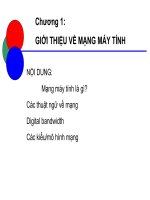giới thiệu về môn máy học
Bạn đang xem bản rút gọn của tài liệu. Xem và tải ngay bản đầy đủ của tài liệu tại đây (8.22 MB, 46 trang )
1
Introduction to machine learning
Nguyen Thi Thu Ha
Email:
• Lecturer:
– Nguyen Thi Thu Ha, lecturer of ITF.
– Email:
– Mobile phone: 0906113373
– Interested in: Machine learning, Natural
language processing, Data mining.
2
• How long time:
– 3 credits.
3
• How to learn:
– English lecture course
– Translation
– Coding
– Presentation
4
• Resources:
– Machine Leaning (Tom Mitchel)
– MLBook
– Conferrences
– Journal
5
Objectives
• Can read and understand English
• Make a problem and how to solution.
• Coding skills
• Presentation
6
Why “Learn” ?
7
Why learning?
• Example problem: face recognition
8
Why learning?
• Example problem: face recognition
9
Why learning?
• Example problem: face recognition
10
Why learning?
• Example problem: text/document classification
11
Why learning?
• Data Mining
– Retail: Market basket analysis, Customer relationship
management (CRM)
– Finance: Credit scoring, fraud detection,
– Medicine: Medical diagnosis
– Telecommunications: Quality of service optimization
– Web mining: Search engines
–
12
Why learning?
• There are already a number of applications of
this type
– face, speech, handwritten character recognition
– market predrecommender problems (e.g., which
movies/products/etc you’d like)
– finding errors in computer programs, computer
security
– etc
13
What We Talk About When We
Talk About“Learning”
14
1
Introduction to Machine Learning
Nguyen Thi Thu Ha
Email:
2
What is Learning?
• Herbert Simon: “Learning is any process by
which a system improves performance from
experience.”
• What is the task?
– Classification
– Problem solving / planning / control
3
Classification
• Assign object/event to one of a given finite set of
categories.
– Medical diagnosis
– Credit card applications or transactions
– Fraud detection in e-commerce
– Spam filtering in email
– Recommended articles in a newspaper
– Recommended books, movies, music.
– Financial investments
– DNA sequences
– Spoken words
– Handwritten letters
4
Problem Solving / Planning / Control
• Performing actions in an environment in order to
achieve a goal.
– Solving calculus problems
– Playing checkers, chess, or backgammon
– Balancing a pole
– Driving a car or a jeep
– Flying a plane, helicopter, or rocket
– Controlling an elevator
– Controlling a character in a video game
– Controlling a mobile robot
5
Measuring Performance
• Classification Accuracy
• Solution correctness
• Solution quality (length, efficiency)
• Speed of performance
6
Why Study Machine Learning?
Engineering Better Computing Systems
• Develop systems that are too difficult/expensive to
construct manually because they require specific detailed
skills or knowledge tuned to a specific task (knowledge
engineering bottleneck).
• Develop systems that can automatically adapt and
customize themselves to individual users.
– Personalized news or mail filter
– Personalized tutoring
• Discover new knowledge from large databases (data
mining).
– Market basket analysis (e.g. diapers and beer)
– Medical text mining (e.g. migraines to calcium channel blockers to
magnesium)
7
Why Study Machine Learning?
Cognitive Science
• Computational studies of learning may help us
understand learning in humans and other
biological organisms.
– Hebbian neural learning
• “Neurons that fire together, wire together.”
– Human’s relative difficulty of learning disjunctive
concepts vs. conjunctive ones.
– Power law of practice
log(# training trials)
log(perf. time)
8
Why Study Machine Learning?
The Time is Ripe
• Many basic effective and efficient
algorithms available.
• Large amounts of on-line data available.
• Large amounts of computational resources
available.
9
Related Disciplines
• Artificial Intelligence
• Data Mining
• Probability and Statistics
• Information theory
• Numerical optimization
• Computational complexity theory
• Control theory (adaptive)
• Psychology (developmental, cognitive)
• Neurobiology
• Linguistics
• Philosophy
10
Defining the Learning Task
Improve on task, T, with respect to
performance metric, P, based on experience, E.
T: Playing checkers
P: Percentage of games won against an arbitrary opponent
E: Playing practice games against itself
T: Recognizing hand-written words
P: Percentage of words correctly classified
E: Database of human-labeled images of handwritten words
T: Driving on four-lane highways using vision sensors
P: Average distance traveled before a human-judged error
E: A sequence of images and steering commands recorded while
observing a human driver.
T: Categorize email messages as spam or legitimate.
P: Percentage of email messages correctly classified.
E: Database of emails, some with human-given labels
11
Designing a Learning System
• Choose the training experience
• Choose exactly what is too be learned, i.e. the
target function.
• Choose how to represent the target function.
• Choose a learning algorithm to infer the target
function from the experience.
Environment/
Experience
Learner
Knowledge
Performance
Element









